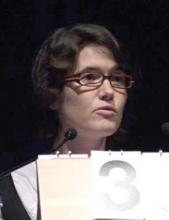AMSTERDAM – Progression from clinically isolated syndrome to clinically definite multiple sclerosis in patients who do not receive early disease-modifying treatment can be predicted by several features on brain MRI and oligoclonal band positivity, according to findings from the MSBase Registry.
Only one factor – the presence of one or more gadolinium-enhancing (GdE) T1 lesions – was a significant predictor of clinically definite MS (CDMS) in patients who received early disease-modifying therapy (DMT) after experiencing clinically isolated syndrome (CIS), Dr. Claire Meyniel reported at the joint triennial congress of the European and Americas Committees for Treatment and Research in Multiple Sclerosis (ECTRIMS/ACTRIMS).
"When facing a patient with CIS, the main point is to know whether or not he or she will develop clinically defined MS," said Dr. Meyniel of the neurology department at the University Hospital Nantes (France).
Predicting which patients with CIS will progress to CDMS has often been difficult, but progress in the diagnosis of MS with MRI during the past 10 years, including recently revised McDonald criteria (Ann. Neurol. 2011;69:292-302), have simplified diagnostic criteria for MS without compromising their specificity, she said.
To determine how these criteria performed in "real-world" clinical practice in the prediction of a second event in patients with CIS, Dr. Meyniel and her coauthors in the MSBase Incident Study obtained the records of 1,266 patients with CIS who had been diagnosed by a neurologist within 12 months of presentation and received at least annual follow-up. The investigators also wanted to find signals that could help to guide clinicians in identifying patients with CIS who might be at higher risk than others for developing CDMS.
MSBase is an online registry containing the records of more than 18,400 patients with MS who are being treated at 59 centers in 17 countries. The registry is run by the MSBase Foundation, a not-for-profit organization located in the Royal Melbourne Hospital in Australia.
The mean age of CIS onset in the patients (71% female) was 32.5 years. Overall, 88% had undergone GdE brain MRI, 50% had undergone lumbar puncture, and 55% had received spinal MRI. Of the 1,266 patients, 292 (23%) had received DMT.
After a mean follow up of 2.7 years, 698 (55%) of patients with CIS had a first relapse and fulfilled criteria for CDMS. The hazard ratio (HR) for conversion to CDMS was 3.02 for patients who had not received DMT, compared with those who had. Receipt of DMT also significantly extended the mean time to first relapse in comparison with no treatment (1.14 years vs. 0.44 years).
The independent predictors of CDMS in multivariate Cox proportional hazards regression analyses of the 974 patients who had not received DMT, included having three or more T2 lesions (HR, 1.41), one or more infratentorial lesions (HR, 1.25), one or more juxtacortical lesions (HR, 1.25), and being oligoclonal band (OCB) positive (HR, 1.47).
In DMT-treated patients, the only independent predictive factor for CIS progression to CDMS was the presence of one or more GdE T1 lesions (HR, 1.66).
"This study underlines the value of early treatment to prolong time to a second event in CIS patients," Dr. Meyniel said, adding that it also identified several MRI predictors that can help determine progression to CDMS.
"This is an interesting project, especially since this is showing ‘real-world’ applicability of criteria and recommendations," said Dr. Heinz Wiendl of the University of Münster (Germany), who was one of the session moderators.
Another session moderator, Dr. Henry F. McFarland, chief of the Neuroimmunology Branch at the National Institute for Neurological Disorders and Stroke, said in an interview that predicting which patients will develop MS or respond to treatment was a challenge for the physician.
"The bottom line is that MRI is probably the best predictor of patients not responding to treatment," he said.
The MSBase Foundation receives financial support in the form of grants from Merck Serono, Biogen Idec, Novartis Pharma, Bayer Schering Pharma, and Sanofi-Aventis. Dr. Meyniel had no personal conflicts of interest to disclose. Dr. Wiendl and Dr. McFarland had no conflicts of interest relevant to the study.


